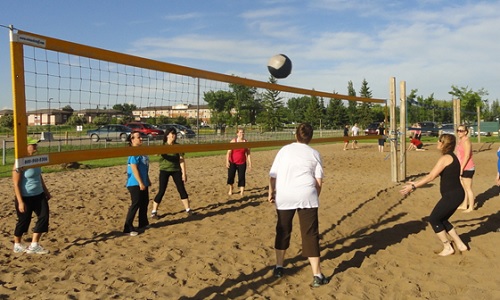Volleyball is regarded as the sixth most popular sport in the world with more than 900 million people from all over the globe either playing or watching it. This popularity can inevitably lead to the creation of separate forms of the game with different rules, equipment or purpose. Some of them have gained mass appeal and recognition, others have remained fairly local developments. Most of them, however, deserve attention and that is why, here in VolleyCountry, we started exploring the alternative forms of volleyball played around the world as a separate sport or for fun. In Part 1, we introduced you to bossaball, ecua-voley, footvolley, 9-man-volley, sepak takraw, shooting volley, sitting volley and wallyball. This time, we are going to present you six more types of the sport, starting with blind volleyball:
An incredibly innovative form of volleyball wherein you can’t see your opponents and their side of the court. It can be played on two sides of a big wall, or with a very high net which is covered by something (blankets, banners, sheets, etc.). The higher the net, the less information you have about what is happening on the other side of the court and the more fun it will be. Here, the role of the referee is essential because no one can see (and, hence – prove) if there is some cheating going on by the opposite side.
Blind volleyball is also very useful as a drill used in the original form of volleyball for improving players’ reflexes and reducing the reaction time. If played on its own, blind volleyball neutralises this obnoxious height factor all short people dread!
Fistball (or Faustball) is a game which dates back from the times of the Roman Empire and was later developed in nineteenth-century Germany. It was there where the sport was significantly popularised, with Fistball now having its own governing body (the International Fistball Association) and World Championships held every four years.
Fistball is a sport played by two teams of five on two sides of a court which is 50 metres long and 20 metres wide! Similarly to volleyball, players aim to send the ball onto the other side of the court and, again, similarly to volleyball – they have only got three touches to do so. However, in fistball, the ball can bounce once between each contact and the final attack is (as the name suggest) a fist-hit rather than a spike (for more information about the rules, see the video).
https://www.youtube.com/watch?v=kI-BBLh98sc
What is the link between volleyball and the former US President Herbert Hoover? Well, it is HooverBall. This is volleyball played with a heavy medicine ball, invented by Herbert Hoover’s physician so that the President can stay fit and healthy. But to warn you in advance – if you decide to play HooverBall, don’t even attempt to set or volley the ball or you will have your fingers broken! Because of the medicine ball’s capacity to harm your body parts, catching and throwing the ball is allowed. It may not sound like a serious sport, but HooverBall can be extremely exhausting (and still fun!). Sometimes used as a warm-up exercise before powerlifting sessions, this form of volleyball can both increase your oxygen-carrying capacity and your muscle strength.
https://www.youtube.com/watch?v=YuQDKHCRiHk
A rather silly mix between volleyball and juggling. Players hold two small juggling balls each and a server throws a third ball to a member of the opposition. The receiver then has to catch the third ball and perform a juggling act with the other two balls in his/her possession before he passes or volleys one of the balls over the net. A team wins a point if a ball drops on the opponents’ floor or if the other team makes a mistake.
https://www.youtube.com/watch?v=rro2dWQmCHs
Played in many American high schools as part of the PE curriculum, Newcomb Ball is the perfect way to start introducing volleyball to young kids. However, if played at a decent level, the game can get quite competitive and be as complex as volleyball itself. The difference between volleyball and Newcomb Ball is that in the latter you have to catch and throw the ball, regardless if it is before serving, passing or volleying. Naturally, no spiking occurs in that form of the sport.
Newcomb Ball has a long history (it was invented by the American woman Clara Baer in 1895) and it has been enjoying significant popularity in the States. In fact, it is the second team sport in the US allowed to be played by women.
https://www.youtube.com/watch?v=1nddWJRgbC4
A mixture of volleyball and water polo, water volleyball is a relatively new sport. Nonetheless, since November 2008 the sport has its own governing body – the International Federation of Water Volleyball. This federation has even introduced some official rules. For instance, the serving is done like in table tennis, with each team serving twice in a row before the opposite team in turn serves two consecutive times. Also, players have to serve within an arm’s reach of the receiver.
Whether you would decide to use the official rules or not is up to you. However, water volleyball can still be a very fun and creative way to start your warm-up for your swimming classes or kill some time on the beach.
https://www.youtube.com/watch?v=Ra0pXhE1KYs





